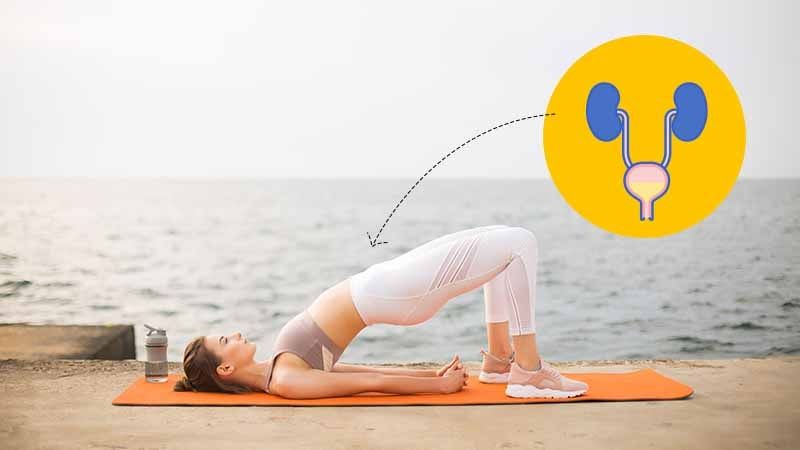Yoga For Urinary System Disorders/ UTIs
- 31 months ago
Our environment is surrounded by germs, some of which are healthy whereas others are contagious. They enter the body via air, water, or wounds and can multiply rapidly in favorable conditions. Urinary tract infections, also known as UTIs, are bacterial infections in the urinary system—kidneys, ureters, bladder, and urethra. Women are more likely to get urinary tract infections than men; they can be more or less severe depending where they infect.
Urinary tract disorders or problems, especially in women, can be frustrating and inconvenient. They are provided with several antibiotic courses to relieve the symptoms, but the underlying cause of the problem is not addressed.
This article will explain how Yoga for Urine Problems can provide overall pain relief and how you can incorporate it into your daily routine.
Symptoms Of UTIs
- Burning Sensation
- Constant urge to urinate
- Passing small, frequent amounts of urine
- Blood in Urine
- Opaque urine
- Strong-smelling urine
- Painful urination
- Fever
- Fatigue & Body Aches
- Pelvic pain in women
- Vomiting & Nausea

Causes Of UTIs
Many factors contribute to the development of any condition in a person. These factors could be the result of a person's lifestyle or routine, or they could be triggered by their anatomical and physiological constitution. On this basis, we consider disease causes to be either lifestyle or physical factors.
Doctors usually aim to treat UTIs with antibiotics. However, you can also practice yoga for UTIs to help with the symptoms.
Yoga Poses For Urinary Infections
Minor, uncomplicated UTIs can sometimes be resolved by the body without the need of antibiotics. Yoga for UTI symptom management aims to replenish depleted energy in the body's reproductive and urinary systems. When the underlying cause of developing UTIs is treated, infections no longer have prominence in the urinary passages.
Here are some yoga asanas for UTIs that can help you alleviate the underlying symptoms. Practice these yoga asanas to achieve effective results and prevent urinary infections.
- Surya Namaskar
- Chair Pose or Utkatasana
- Triangle Pose or Trikonasana
- Squat Pose or Malasana
- Anulom Vilom Pranayama
1. Surya Namaskar
It's the most important "Pranic Regenerator." For maximum benefit, perform Suryanamasakar at sunrise.

12 steps/asanas involved in Suryanamaskar
- Yoga Asana 1: Pranamasana (Prayer pose)
- Yoga Asana 2: Hastauttanasana (Raised arms pose)
- Yoga Asana 3: Hastapadasana (Standing forward bend or Hand to foot pose)
- Yoga Asana 4: Sanchalanasana Ashwa (Equestrian pose)
- Yoga Asana 5: Svanasana (Adho mukha svanasana) (Downward facing dog pose) OR Tadasana (Mountain Pose)
- Yoga Asana 6: Ashtanga Namaskara Yoga (Salute with eight parts)
- Yoga Asana 7: Bhujangasana (Cobra pose)
- Yoga Asana 8: Svanasana (Adho mukha svanasana) (Downward facing dog pose) OR Tadasana (Mountain pose)
- Yoga Asana 9: Sanchalanasana Ashwa (Equestrian pose)
- Yoga Asana 10: Hastapadasana (Standing forward bend)
- Yoga Asana 11: Hastauttanasana (Raised arms pose)
- Yoga Asana 12: Tadasana (Mountain Pose)
Check guided video performed by yoga expert on Wellness TV
2. Chair Pose or Utkatasana
Utkatasana strengthens the pelvic floor and improves digestion. It activates and strengthens the bladder muscles, thereby assisting with UTIs.
- Stand with your feet close to each other and arms on your side.
- Now, lift your arms over your head. Make sure your fingers are close to your ears, pointing towards the sky.
- Bend your knees to achieve a partial squat position. Your thighs and knees should be parallel to the floor.
- Lean your upper body/torso forward.
- Hold this position for 10-15 breaths.
3. Triangle Pose or Trikonasana
Trikonasana provides strength to the legs, knees, arms, chest, and ankles.
- Stand upright with your legs apart. Keep the distance between your legs a bit more than the distance of your shoulders i.e. Approx 3.5 to 4 feet apart. Adjust yourself according to your height.
- Just turn the left foot a little inwards and open the right leg outwards at 90 degrees.
- Engage the thighs, keeping pelvic neutral, back erect, and shoulders relaxed. Don’t put strain on the knees.
- Start inhaling and raise your left hand slowly straight above your head. Bring the right hand near the shin and if you need support you can place it there for a second or so.
- Exhale, bend your torso and extend the bending from the hip joint towards your right ankle. Don’t bring the head too close to the shoulder.
- Try bending more till your fingers are at your ankle. Avoid bending the body forward. Hold the pose for 20-30 seconds.
- Come back in the standard position slowly and repeat the process on the other side.
4. Squat Pose/Garland or Malasana
The key focus of this pose is to improve your digestion system and tone your abdominal muscle. Malasana helps to relax your body and senses while strengthening your lower body and digestion.

- Stand straight on your yoga mat. Keep your hand in a prayer position at the center of your chest.
- Fold your knees while lowering the hips. Go into a squat position. Keep your thighs separated wider than your upper abdomen while keeping your feet closer.
- Push your torso forward and take your arms between your knees.
- Press the elbows on the inner part of your knees if possible.
- Elevate and lengthen your torso, while keeping your spine erected and relaxing your shoulder. Try to shift your body weight on your heels.
- Hold the position for at least five breaths. Release the pose by bringing your fingertips to the yoga mat. Smoothly strengthen your legs and come back in samsthithi position.
5. Anulom Vilom Pranayama
It aids in reducing stress and anxiety as well as improving general well-being.
- Choose a comfortable meditation position. You may sit on a chair or on the ground, whatever suits you the best.
- Keep your spine erect and close your eyes. Let go of any other thoughts and clear your mind.
- Place your thumb on your right nostril to obstruct the airflow and inhale through the left nostril slowly. Let the other hand rest on your knees.
- When your lungs are full, shut both the nostrils and hold your breath for a second.
- Release the thumb and exhale through the right nostril. Place your middle finger on the left nostril at the same time to obstruct airflow.
- Focus on your breathing and now do it reverse by inhaling through the right nostril and exhaling through the left.
- Keep repeating through alternate nostrils and continue this for 10 minutes.

Conclusion
All of the asanas in Yoga for UTI relief can help you stretch your body, strengthen your pelvic floor, and help your digestive system. You are not required to practice Yoga for an extended time. With only a few minutes of doing Yoga, you will start observing positive results once you practice it every day. If you wish to know more about Yoga for UTIs and its effects on your body, consult a urologist online.








